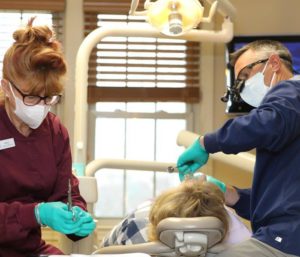BACK TO THE BASICS
September 12, 2022
 Every once in a while, someone will say, “There must be a lot less cavities today than there were years ago because of improved home care, fluoride, etc., right?” Maybe in general, but there is still way too much decay. Poor diet and home care are the two most common culprits leading to decay. Dentists have seen a significant increase in decay during COVID. When and what you eat and drink is important. Improvement in home care means changing what is being done now, and requires discipline.
Every once in a while, someone will say, “There must be a lot less cavities today than there were years ago because of improved home care, fluoride, etc., right?” Maybe in general, but there is still way too much decay. Poor diet and home care are the two most common culprits leading to decay. Dentists have seen a significant increase in decay during COVID. When and what you eat and drink is important. Improvement in home care means changing what is being done now, and requires discipline.
Yesterday, I went into one of my hygienist’s rooms to check her patient, a 13-year-old boy, and asked the hygienist how his home care was, because his gums were bright red. She said to me, “Jack, why don’t you tell the doctor how often you told me you brush your teeth.” The boy answered, “About once a week.” ONCE A WEEK?!?! Add the fact that he is in braces, which makes it even more important to keep the teeth clean.
It’s important sometimes to step back and review the basics, so here they are. At a minimum, you should brush with a fluoride toothpaste at least twice a day for two minutes. A good electric toothbrush is preferable to a manual toothbrush. When I say “good”, I mean one that sits on a charger, and not one that takes AA batteries. There are two major brands out there. I prefer the one that starts with an “O”.
It amazes me how many people don’t floss their teeth. I have heard every excuse in the book; “My fingers are too big”, “I don’t have the time”, “It’s too hard”, “My dog ate the floss”. Just like anything else, it is always hard to start a new ritual. There are so many different kinds of floss and gadgets to help floss that there is something out there for everyone. And if you can’t seem to make it work, use a water pik; it works better than floss anyway.
Bacteria, which accumulates on and between the teeth, forms that white film called plaque. Plaque contains billions of colonized bacteria. The right kind of bacteria, along with the wrong king of diet and the wrong genetics can produce cavities. Plaque that is not removed with thorough daily brushing and flossing can harden and turn into calculus (tartar). These colonized bacteria can then lead to tissue inflammation (gingivitis), the early stage of periodontal (gum) disease.
Brushing your teeth helps get rid of most of the plaque, except for the stuff that accumulates between the teeth. That is what floss and the water pik are for. I know it sounds gross but if you want to know what your breath smells like, floss a few teeth and then smell the floss. That should turn you into an avid flosser.
The routine should be, floss (water pik), brush, rinse. The whole event should be around five minutes. Believe me, you have five minutes. Cleaning between the teeth first allows the fluoride from the toothpaste to contact a cleaner tooth surface between the teeth. I prefer a non-alcohol-based rinse, as alcohol is drying and creates a better environment for bacteria to thrive.
If you do choose floss, technique is important. Proper flossing is not popping the floss between the teeth and shooting it right back up. The proper way to floss is to get the floss between the contact of the teeth, slide the floss gently under the gum tissue around one tooth, “shoe-shine” the side of the tooth, gently move the floss over the papilla (the little piece of gum between the teeth), “shoe-shine“ the side of the other tooth and then bring the floss up. At your next dental visit, ask your hygienist to evaluate your flossing skills to make sure you are doing it correctly.
You have the 5 minutes twice a day.
Dr. St. Clair maintains a private dental practice in Rowley and Newburyport dedicated to health-centered family dentistry. He has a special interest in treating snoring, sleep apnea and TMJ problems. If there are certain topics you would like to see written about or questions you have, please email them to him at jpstclair@stclairdmd.com
THE DENTAL EXAM
September 6, 2022
 Diagnosis is the key to success in any area of medicine, including dentistry. Proper diagnosis leads to success in treatment. In dentistry, there are different exams used at different times of a patient’s “career” at the dental office. I would like to clarify some of these in this column.
Diagnosis is the key to success in any area of medicine, including dentistry. Proper diagnosis leads to success in treatment. In dentistry, there are different exams used at different times of a patient’s “career” at the dental office. I would like to clarify some of these in this column.
The Comprehensive Oral Evaluation is the term used to describe the initial exam with a new dentist. This evaluation usually is a more detailed exam performed by the dentist. It includes charting of the patient’s teeth (including present/missing teeth and existing restorations), a periodontal exam (to determine the health of the gums and bone that support the teeth), a visual oral cancer screening (a detailed exam of the soft tissues to check for any abnormalities), a review of the patient’s health history (including familial history, medications, etc.), and a general occlusal exam (an evaluation of how the teeth, muscles and TMJ joints are working together). This exam is used as the baseline for where a patient starts in an individual dental practice.
Dentists may spend 60-90 minutes with a patient to do this initial exam. In dental offices that have a particular focus on whole body wellness, this may also include salivary testing, a deep dive into WHY things are happening that should not be happening, a sleep breathing disorder screening, and communication with other health care providers to provide comprehensive care.
The Periodic Oral Evaluation is the exam that is done in conjunction with visits to the hygienist. It is separate from the “cleaning” of the teeth. This exam generally looks at the same areas as the previous exam described, but in less detail. The results of this exam are compared to the baseline exam that has been previously completed. Although the exam must be overseen by a dentist, many of the parts of the exam may be performed by the hygienist and reviewed by the dentist.
The Limited Oral Evaluation is the term used to describe an unscheduled visit to the dentist, usually for when a patient presents with a problem. For example, if a patient presents with the chief complaint of a toothache, this exam covers the reading of any necessary dental x-rays and diagnosis of the problem. It may result in the scheduling of the patient for treatment, or referral to a specialist.
There is also the underutilized Occlusal Analysis. It is often done as part of the comprehensive exam, however some patients who have certain “bite” issues, need a more focused evaluation of this area. This exam serves a very distinct and important role in the diagnosis of many issues that patients encounter, which can lead to much greater success in treating these patients.
Temporomandibular joint (TMJ) issues, muscular problems, tooth wear/fracture and pre-prosthetic evaluation are all things that could benefit from the occlusal analysis. It is generally a combination of a clinical exam and an evaluation of models of a patient’s teeth, which are mounted on an instrument which simulates the patient’s jaw movements. This is often done digitally with scanning and software now.
Ideal is a Comprehensive Oral Evaluation for each new dentist you see in your lifetime (the fewer the better), a Periodic Oral evaluation every 6 months or one year depending on your needs, and to never need a Limited Oral Evaluation because you are a stellar dental patient who is being managed by a conscientious dental team.
Dr. St. Clair maintains a private dental practice in Rowley and Newburyport dedicated to health-centered family dentistry. He has a special interest in treating snoring, sleep apnea and TMJ problems. If there are certain topics you would like to see written about or questions you have, please email them to him at jpstclair@stclairdmd.com
OUTSIDE THE DENTAL BOX
August 29, 2022
 You may have heard the phrase “the mouth is the gateway to the rest of the body.” The mouth is connected to the rest of the body, and the only healthcare providers who spend time examining this area are your dental team. The days of the dentist being just the “tooth fixer” are gone. The key here is the practitioner thinking “outside the box” and treating each patient’s total-body health.
You may have heard the phrase “the mouth is the gateway to the rest of the body.” The mouth is connected to the rest of the body, and the only healthcare providers who spend time examining this area are your dental team. The days of the dentist being just the “tooth fixer” are gone. The key here is the practitioner thinking “outside the box” and treating each patient’s total-body health.
The average physician spends seven minutes every two years with a patient. There may be a 5 second glance inside the mouth during those visits. If you see a dentist on a regular basis, we (dentists and hygienists) spend an hour twice a year concentrating on a very specific region of the body. There is a lot of information available within that tiny little space.
For example, everyone has heard of gum or periodontal disease. While many patients and dentists see periodontal disease as a tooth or oral health problem, the fact is, it is a bacterial disease and bacteria can travel throughout the body. About a dozen of the nearly 7,000 types of oral bacteria can wreak havoc on the body, not just the oral cavity.
In a study that looked at blood clots from acute heart attack and stroke patients, researchers found that oral bacteria in the clots were 16 times more concentrated than in the surrounding blood. I think it is safe to say that sometimes there is more going on than what we can see in the dental chair.
Some dentists are recommending salivary testing as they believe that it is a crucial part of diagnosing and reversing oral bacteria and inflammation. The salivary tests can show whether patients have abnormally high levels of the specific bacteria associated with heart disease, diabetes, and other systemic conditions. Diagnosis can then lead to treating the bacteria with a combination of antibiotics, antimicrobials and specific homecare techniques. In a perfect world, this information would be shared with the rest of the patient’s medical team to be able to provide comprehensive total-body care.
This is the same reason many dentists screen patients for sleep-disordered breathing. Sleep affects the function of the entire body. For a dentist, there is more to screening for sleep apnea than simply asking patients about snoring. Bruxing (grinding), clenching, and gastric reflux are just a few other signs to look deeper and ask more questions. It is believed that some patients who grind or clench their teeth at night do so as the bodies response to poor air flow. In addition, experts feel that many children diagnosed with attention deficit disorders may have airway problems that are contributing to, or causing the problem.
Nutrition is another area that should have more emphasis from the dental community. While dentists and hygienists often talk to patients about how sugar affects teeth, they should also be educating patients on how other foods, such as processed carbohydrates, cause body-wide inflammation.
This just touches on some of the systemic issues which can be screened for, and make a huge difference in patient lives. There is a link between your mouth and the rest of your body.
Dr. St. Clair maintains a private dental practice in Rowley and Newburyport dedicated to health-centered family dentistry. He has a special interest in treating snoring, sleep apnea and TMJ problems. If there are certain topics you would like to see written about or questions you have, please email them to him at jpstclair@stclairdmd.com
DENTISTRY IN THE NEWS – PART 2
August 22, 2022
 Last week I discussed some of the content that was presented in a recent U.S. News & World Report which featured seven pages of information on dentistry. This is a continuation of that.
Last week I discussed some of the content that was presented in a recent U.S. News & World Report which featured seven pages of information on dentistry. This is a continuation of that.
One of the columns in this section of the report entitled, “Guarding Kids’ First Choppers”, mentions that childhood tooth decay is “the most prevalent chronic disease in children”. This is true. According to the report, 28 percent of preschoolers have dental decay. There are many factors that contribute to dental decay, including poor dietary habits and insufficient oral hygiene. This increase is not only in preschoolers but right through high school.
However, the column goes on to say that “dental visits should begin no later than a child’s first birthday”. I think that is a little early and usually recommend seeing children by age three. However, parents should closely inspect their children’s teeth. If there is anything that is seen that is not tooth-colored or doesn’t look right, the child should be seen by a dentist. Pediatric dentists are one option but many general family dentists are more than willing to see children. If there are issues that warrant a pediatric specialist, the child can be referred.
Another column in the report entitled, “The Wisdom on Wisdom Teeth”, says “the latest data suggests that as many as 80 percent of people will develop problems with their wisdom teeth”. This is true. In most people, wisdom teeth either will not fit with all of the other teeth in the mouth or they erupt crowded. This may not cause a problem right away, but because they are difficult to clean, they either get decay or cause periodontal problems with the neighboring teeth. The current line of thinking is to remove these teeth between the ages of 16-18, or before the roots are fully developed. This generally makes for a much less traumatic surgery.
In the article entitled, “Taking the Cost Out of the Bite”, it is discussed what to do if you don’t have dental insurance. One of the suggestions is “to consider purchasing an individual dental policy”, and the other is to look for discount programs which “give members 10 to 60 percent off at certain providers”. This is tricky. If you don’t get dental insurance from your employer or are not covered under a spouse’s plan, you really have to look at the numbers and also at what you are entitled to with particular plans. If it seems too good to be true, it probably is.
The cost of purchasing your own indemnity dental insurance plan usually outweighs the benefits. Most, if not all dental insurance plans have annual maximums which average $1000 per year. You pay the premium to the insurance company, which might be $750 a year, but then you only get $1000 in benefits. It may make sense for families but usually not for individuals. As far as the “discount plans” the column refers to – this is a buyer beware. These plans force you to choose a dentist from a list and this list is usually not very long. If a dentist is willing to accept 50% of their normal fee for a procedure, it is important to consider the quality of care.
Dental health is important to overall health on many different levels. Make it a priority!
Dr. St. Clair maintains a private dental practice in Rowley and Newburyport dedicated to health-centered family dentistry. He has a special interest in treating snoring, sleep apnea and TMJ problems. If there are certain topics you would like to see written about or questions you have, please email them to him at jpstclair@stclairdmd.com
DENTISTRY IN THE NEWS – PART 1
August 15, 2022
 A recent U.S. News & World Report featured seven pages of information on dentistry. Although I was surprised that most of the information was accurate, as the media often skews the facts to make a point, there were a few things that I felt needed clarification.
A recent U.S. News & World Report featured seven pages of information on dentistry. Although I was surprised that most of the information was accurate, as the media often skews the facts to make a point, there were a few things that I felt needed clarification.
The first article highlights the fact that 75% of adults have some form of periodontal disease. This is true. It also mentions many of the known facts with regards to gum disease and systemic health. One of those is that uncorrected gum problems can make it more difficult for diabetics to control their blood sugar, and in turn worsen their gum problems. This is also true.
With regards to brushing, the article states, “Scrubbing with fluoride toothpaste robs oral bacteria of sustenance.” This is true to some extent but the term “scrubbing” is not completely accurate. Proper brushing technique with either a very soft manual toothbrush or good electric toothbrush is a more accurate description. Also, fluoride, in and of itself, is not truly anti-bacterial. Although it is felt that its anti-cavity action is related mainly to effects on mineral phases of teeth and on the process of remineralization (strengthening enamel), research does show that fluoride also has important effects on the metabolism of bacteria in dental plaque. There are other ingredients in toothpastes with and without fluoride that are more anti-bacterial, but it is the removal of plaque manually that is most important, even without toothpaste.
With regard to electric toothbrushes, the article insinuates that “basic” and “cheap” ($7) models are as effective as more expensive models. This is false. Although you do not have to buy the most expensive model available, there is a huge difference in effectiveness between a $7 battery-operated toothbrush and a $70 wall-charged one.
The article states, “Only floss can reach below the gum-line.” This is not completely true. Proper toothbrush technique gets below the gum-line on two sides of the teeth. Floss is important for removing debris between teeth. A water pik is probably most effective for cleaning the non-brushable areas in the mouth.
For combating bad breath, the article’s first suggestion is to “brush your tongue.” Although it mentions the use of a tongue scraper, it only states the use of this device if your toothbrush makes you gag. The fact of the matter is that a tongue scraper is 100% more effective in removal of the nasty bacteria on your tongue. If the toothbrush makes you gag so will the tongue scraper. One trick is to scrape your tongue while you are exhaling.
An article in the report entitled, “21st-Century Dentistry” highlights the use of lasers in treating gum problems. The beginning of the column gets you revved-up to believe that this is the best thing since sliced bread, but the end of the article states differently. “It is unlikely to fully replace traditional gum surgery anytime soon. The laser therapy isn’t demonstrably superior to surgery, researchers recently reported in the Journal of Periodontology.”
To be continued…….
Dr. St. Clair maintains a private dental practice in Rowley and Newburyport dedicated to health-centered family dentistry. He has a special interest in treating snoring, sleep apnea and TMJ problems. If there are certain topics you would like to see written about or questions you have, please email them to him at jpstclair@stclairdmd.com
DENTAL INSURANCE – PART 3/3
August 8, 2022
 In the last couple of columns I discussed the state of dental insurance in 2022. If you missed them you can read them at www.thetowncommon.com or my blog. The basic gist was that the dental insurance industry has not changed significantly in 40 years.
In the last couple of columns I discussed the state of dental insurance in 2022. If you missed them you can read them at www.thetowncommon.com or my blog. The basic gist was that the dental insurance industry has not changed significantly in 40 years.
It’s great if you get dental insurance from your employer for regular dental hygiene visits and have relatively small amounts of dental work to do. However, there are only a few reasons to purchase dental insurance on your own, even if you need a significant amount of dentistry. In this column, I will discuss the best strategies to get the dental care you need.
One thing is certain; most dental problems do not go away, and almost always get worse over time. Although pain is a good indicator that there is a problem, pain is also not a good indicator that there is not a problem. Many, if not most, dental problems do not cause pain. Cavities, gum disease, wear or erosion of the teeth, often do not cause pain until there is a significant problem, which then requires extensive and expensive treatment to solve. Therefore, the first and most important strategy is regular dental visits.
All too often I see people who have not been seeing a dentist on a regular basis and then have a problem that brings them to the dental office. The most reported reasons for having not been to a dentist are lack of insurance or lack of concern because “everything has felt fine up until now”.
As in most things in life, we have to make choices about what to do with our time and our money. Dentistry is no different. It is a mindset and a budgeting issue. If you value your health and overall self-care, regular maintenance visits to your dentist are the best thing you can do for yourself. If you have any type of dental insurance, at least you have some coverage for this. If you do not have dental insurance, budgeting the average $30 per month it costs over a year to have your teeth cleaned, x-rayed and examined is a smart move, and doable for most.
After you have made the decision to budget for maintenance, regardless of how much other dentistry you need, or think you need, the second key is to be in a dental office that you are comfortable with. It is vital for there to be a mutual level of trust and respect. It is imperative for the dental office to understand you, the patient; where you are in your life, and how to get the most important thing out of your decision to seek care – to keep your teeth healthy for your lifetime.
There is no disputing that dentistry costs money, regardless of whether you have any coverage or not. Dental insurance is not intended to cover 100% of dental needs. There are so many options out there for people who require more extensive care. However, the key is – what is suitable for you? Patients need to be guided into care and not sold a commodity. There are many reasons that individuals choose a specific provider, but the most important factor is if you feel good about where you are.
When you go to buy a house, does the real estate agent show everyone the same house? No. They show them what fits into their life at that particular time. Dentistry should be approached the same way. It may not be the right time in your life to have the four bedroom house and the three car garage. But, having a good solid roof over your head that is comfortable is important to everyone. This is regular dental maintenance. You can always upgrade.
Dr. St. Clair maintains a private dental practice in Rowley and Newburyport dedicated to health-centered family dentistry. He has a special interest in treating snoring, sleep apnea and TMJ problems. If there are certain topics you would like to see written about or questions you have, please email them to him at jpstclair@stclairdmd.com
DENTAL INSURANCE – PART 2/3
August 1, 2022
 Last week I explained how dental insurance works in general, and why there is no “good” dental insurance. This week I will break down the general differences between dental insurances, offer some things to consider when using your dental insurance, and when it makes sense to consider purchasing insurance if you don’t have it.
Last week I explained how dental insurance works in general, and why there is no “good” dental insurance. This week I will break down the general differences between dental insurances, offer some things to consider when using your dental insurance, and when it makes sense to consider purchasing insurance if you don’t have it.
We get asked just about daily by patients who are either self-employed or are not offered insurance through their employer, “Should I consider getting dental insurance?” In most cases, it does not make sense to purchase dental insurance on your own. This goes back to last week’s column as to how dental “insurance” is set up to begin with.
As discussed last week, all dental insurance companies set a limit as to how much they will “pay-out” on an annual basis. The industry average is $1000 per year, which has not changed since the inception of dental insurance back in the 1970’s. The premiums for individual dental insurance run around the $700 range. This leaves the patient with a net gain of $300 from the insurance company. This especially does not make sense if you typically only have your teeth cleaned a couple of times a year. The only way purchasing your own insurance may make sense is if you are looking to cover your entire family. You should discuss these factors with your dental office prior to making the decision. Key: You should be the one to make the decision who you pick as a dental provider, not an insurance company that might be a different company or have a new set of rules next year.
In dentistry, there are a few types of dental insurance available. There are “open” insurance plans, where patients can go to whoever they want and a certain percentage of the fee will be covered depending on the procedure. The other types of insurance are PPO’s, HMO’s and discount plans or “clubs”. With these types of insurance, the dentist has to sign a contract with the insurance company and abide by a pre-set limit they can charge for all procedures. While this may sound good from a patient perspective, there are other things to consider.
Many private dental offices are being bought-up by larger corporations across the country. In general, the business model of these practices is to see a higher volume of patients to do more procedures. There will be less and less privately-owned dental practices as time goes on. However, in our area right now, most dental offices are small businesses. The decision for the dentist to sign-up for a particular plan depends on many factors.
As a consumer, and patient, you have to be the one to decide what is important to you. Keep in mind that dentistry is not a commodity. Dentistry should be relationship based. Approaching it this way will give you the best opportunity to get the level of care that is right for you.
Please keep in mind: Insurance does not equal health. Health requires investment and personal responsibility. Better access to care across the general population is a topic for another time. Right now, you have full control in managing your dental health care. You should talk to your dental office about any concerns you have.
Next week I will discuss the costs of dental care for those with or without dental insurance and ways to get what you want with regards to your dental health.
Dr. St. Clair maintains a private dental practice in Rowley and Newburyport dedicated to health-centered family dentistry. He has a special interest in treating snoring, sleep apnea and TMJ problems. If there are certain topics you would like to see written about or questions you have, please email them to him at jpstclair@stclairdmd.com
DENTAL INSURANCE – PART 1/3
July 25, 2022
 As you can imagine, most dental offices are bombarded daily with questions about dental insurance. “Do you take my plan? How much is covered? Why is dental insurance coverage so bad?” These are just a few of the questions we hear daily. So, why is dental insurance the way it is?
As you can imagine, most dental offices are bombarded daily with questions about dental insurance. “Do you take my plan? How much is covered? Why is dental insurance coverage so bad?” These are just a few of the questions we hear daily. So, why is dental insurance the way it is?
Dental insurance was first offered back in the early 1970’s. Back then, the first insurance companies offered a yearly maximum benefit level of $1000 per year per patient. In 2019, those insurance companies, and many others, offer an average yearly benefit of $1000 per year. Yes, you read that correctly; it has not changed. However, back in the 70’s you could have gotten a lot more dentistry than you can today for that same $1000. Why hasn’t it changed?
There are many answers to this question. The bottom line is that raising the dental insurance limits would be extremely unprofitable for insurance companies. Here are some reasons why.
First is the “use” factor. Many patients who have dental insurance use their insurance right up to that yearly maximum. This is generally not the case with other types of insurance. In fact, the entire dental insurance model is based on a certain percentage of those insured not using their benefits at all. If the yearly benefit was higher, the premiums would need to be much higher for the insurance companies to make a profit. This would destroy the model and there would be many fewer patients signing up for those plans.
The second reason is pre-existing conditions. Many dental problems are often ignored for years and patients will often wait until they have “insurance” to take care of their problems. This is why many insurance companies have a “wait period” for certain dental procedures. When that patient finally has dental coverage and the dentist tells them they need three root canals and three crowns they are shocked to hear that their insurance will only cover a small percentage of the treatment. There is no dental insurance available to cover situations like this because it would be extremely unprofitable for the insurance companies.
Next is the fact that dental problems are much more common than many other health problems. This goes back to my first point – the “use” factor. Look at how expensive medical insurance is. For many people, they may go for routine check-ups to their doctor, but a much lower percentage of patients use their insurance for more costly procedures. However, we all need the health insurance in case of that catastrophic event that would otherwise bankrupt us. For dental insurance companies to remain profitable they have to charge a high enough rate to offset the “people using it” factor, but also a rate low enough for it to be “worth it” for the typical consumer.
So, in reality, we are all sort of stuck with the way it is. To provide “full coverage” for dentistry, insurance companies would have to charge more for premiums than most people would deem worth spending. This situation is unfortunate but there is no end in sight to combat this.
Next week I will expand on this with a discussion of the difference between the different kinds of dental insurance available: those you can go to whoever you want and those where you may be asked to pick a dentist from a list.
Dr. St. Clair maintains a private dental practice in Rowley and Newburyport dedicated to health-centered family dentistry. He has a special interest in treating snoring, sleep apnea and TMJ problems. If there are certain topics you would like to see written about or questions you have, please email them to him at jpstclair@stclairdmd.com
LESSONS LEARNED
July 18, 2022
 I have focused the majority of my career on family preventive and general dentistry. While I enjoy most aspects of what I do, I firmly believe that a good percentage of dental problems are avoidable, which means that dentists shouldn’t be as busy as we are with routine fillings, removal of teeth, and many other procedures. While there are other factors at play, such as genetics, personal responsibility is often at the head of the pack.
I have focused the majority of my career on family preventive and general dentistry. While I enjoy most aspects of what I do, I firmly believe that a good percentage of dental problems are avoidable, which means that dentists shouldn’t be as busy as we are with routine fillings, removal of teeth, and many other procedures. While there are other factors at play, such as genetics, personal responsibility is often at the head of the pack.
Prevention often takes a back seat to fixing problems. Decayed, broken and worn teeth all had nothing wrong with them at some point. Granted, you have to fix what is already broken, but “How could it have been prevented?” has always been the question I ask myself, and try to make my patients understand.
What are the factors at play for the 6 new cavities? What could have been done to avoid the wearing-down of all the teeth? Could anything have been done during growth to alter how the airway develops? What factors are causing the chemical erosion of the teeth? These are important questions to be considered.
Much of what is being marketed to dentists today is technology; 20 years ago, it was cosmetics. The technology available today in dentistry is really cool, just like the technology available in most other areas of our lives. There are some things I would not want to live without since adding them to our office; digital x-rays, digital scanning instead of messy impressions, computer-generated restorations, telemedicine, etc. However, how much technology do we really need if we avoid the problems in the first place?
Let me give an example. If I had to pick the single most important “technology” that has impacted dentistry in the last 30 years, it would be dental implants. Grafting of bone and dental implants have changed the lives of many people, who would otherwise have been forced to wear something removable in their mouth to replace teeth. And, while this is a great service to patients, I’m still always thinking, “What are the lessons I have learned to help my next patient avoid needing all this dentistry?”
More dentists are being trained to place dental implants, not only to replace one missing tooth, but to replace ALL the teeth. You may have seen the commercials from a large dental franchise with stories from “real” patients who have had dental implants change their lives. What they don’t tell you is that they remove all the teeth, even ones that can be saved, remove a ton of bone to be able to place 4-6 dental implants, to then have a piece of plastic with plastic teeth screwed to it. They claim – “You can put an end to dealing with missing teeth or repetitive dental work with dental implants.”
You have to go in for the consultation to find out that upper and lower “All-on-4” dentures attached to implants will run you $60K+. They also fail to mention in any of the advertising that there is maintenance that can be costly. And, they don’t really feel like teeth. While this treatment may be acceptable for some patients, the clear choice is to avoid it.
Keeping your natural teeth makes much more sense. Improving and maintaining any part of our health requires time, commitment and resources. There are many great dentists out there to help you maintain your teeth for a lifetime.
Dr. St. Clair maintains a private dental practice in Rowley and Newburyport dedicated to health-centered family dentistry. He has a special interest in treating snoring, sleep apnea and TMJ problems. If there are certain topics you would like to see written about or questions you have, please email them to him at jpstclair@stclairdmd.com
UNDERSTANDING YOUR BENEFITS
July 11, 2022
 I think it is safe to say that our healthcare system has some flaws. Wouldn’t it be nice to have a healthcare system that realized that everything in the body is connected? Unfortunately, there are no reasonable solutions for this in the near future. Therefore, it is important for you to take your health into your own hands and plan appropriately.
I think it is safe to say that our healthcare system has some flaws. Wouldn’t it be nice to have a healthcare system that realized that everything in the body is connected? Unfortunately, there are no reasonable solutions for this in the near future. Therefore, it is important for you to take your health into your own hands and plan appropriately.
Patients will sometimes balk at treatment not covered by their dental insurance. Dentists will often hear, “Just do what my insurance covers. I don’t want anything extra.” In fact, a recent ADA poll showed that a lack of dental insurance was the #1 reason most patients gave for not visiting a dentist. Here are some frequent questions patients often ask about dental insurance.
Why doesn’t my insurance cover all of the costs for my dental treatment?
Dental insurance isn’t really insurance (defined as a payment to cover the cost of a loss) at all. It is a monetary benefit, typically provided by an employer, to help their employees pay for routine dental treatment. “Dental Insurance” is only designed to cover a portion of the total cost.
But my plan says that my exams and other procedures are covered at 100%.
That 100 percent is usually what the insurance carrier allows as payment towards a procedure, not what your dentist may actually charge. Dentist’s fees are usually a reflection of the level and quality of care in a particular office. Some cost more, some cost less, depending on the costs of running their office, how much they pay their staff, the materials they use, etc. An employer usually selects a plan with a list of payments that corresponds to its desired premium cost per month. Therefore, there usually will be a portion not covered by your benefit plan.
If I always have to pay out-of-pocket, what good is my insurance?
Look at medical insurance. Many people have been forced into high deductible plans ($2000 or more). Most dental plan deductibles are $50. While dental insurance is far from ideal, any amount that reduces your out-of-pocket expense helps.
Why is there an annual maximum on what my plan will pay?
Although most maximum amounts have not changed in 30+ years, a maximum limit is your insurance carrier’s way of controlling payments. Dental plans are different from medical plans, in that dentistry is needed frequently. Medical emergencies are rare. It is your dentist’s responsibility to recommend treatment based on diagnosis and treatment planning of what is appropriate for your dental health, not necessarily what your dental plan covers.
If my insurance won’t pay for this treatment, why should I have it done?
It is a mistake to let your benefits be your sole consideration when you make decisions about dental treatment. People who have lost their teeth often say that they would pay any amount of money to get them back. Your smile, facial attractiveness, ability to chew and enjoy food, and general sense of well-being are dependent on your teeth.
Other than complaining to your dental insurance company or your Employee Benefits Coordinator, your best defense is to budget for dental care. First, find a provider based on a personal fit for you. That is the single most important thing you can do. If that office can’t work with you financially then I would find another office.
Dr. St. Clair maintains a private dental practice in Rowley and Newburyport dedicated to health-centered family dentistry. He has a special interest in treating snoring, sleep apnea and TMJ problems. If there are certain topics you would like to see written about or questions you have, please email them to him at jpstclair@stclairdmd.com







